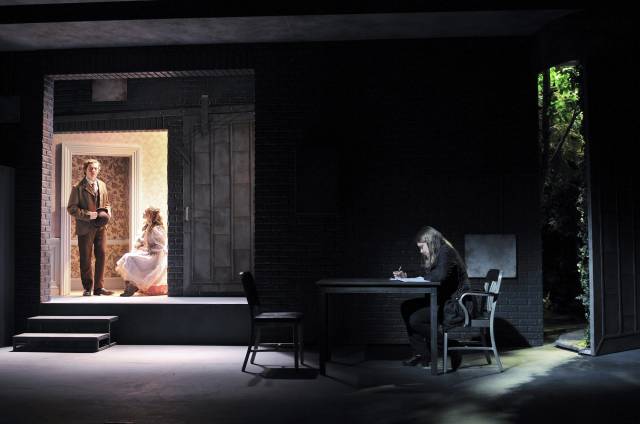

There are two world depicted in Jennifer Haley’s new play The Nether. There is our world, which is depicted as a dark and drab interrogation room, and there is “The Hideaway”, a startlingly bright and beautiful world where one goes to escape the drudgery of the real world. Yet this gorgeous alternate realm holds something terrifying underneath the surface.
The Nether plays like a detective story. When the play opens, we see Morris (Merritt Weaver) and Sims (Frank Wood) at an interrogation table. We find out that Morris is investigating a realm of “the nether” (a virtual reality mutation of the internet) called “The Hideaway”. “The Hideaway” is a bright, colorful, and lush world set in the Victorian age. It is also a place where pedophiles and child murderers can act on their desires without consequences. Sims is the creator of “The Hideaway”, where he acts as an entity named “Papa”. Simultaneously, we see Morris interrogating Doyle (Peter Friedman), an award-winning middle school teacher who was somehow involved in “The Hideaway”, and the investigation of “The Hideaway” itself, conducted by Woodnut (Ben Rosenfield). We also meet Iris, a young inhabitant of “The Hideaway” played by Sophia Anne Caruso.
The contrast between the two worlds is vividly depicted by set designer Laura Jellinek, costume designer Jessica Pabst, and lighting designer Ben Stanton. The “real world” is stark, imposing, and dreary. “The Hideaway” is decked out in startlingly bright pastel colors. Director Anne Kauffman and the designers have made a smart choice in not letting the beauty of “The Hideaway” overtake the stage. We see portions of it through doorways and portals, only allowing us a glimpse of this world. This allows us to keep in mind the terror that is actually going on, and not be entirely seduced by it. We nonetheless understand why someone would want to escape into this seemingly idealistic world, even if its principals are horrific.

Ms. Haley’s strength as a playwright is seamlessly creating and building a slightly futuristic world that is highly plausible. With the rapid rise of technology and social media, the possibility of creating and visiting lifelike realms where we can act out our deepest, darkest desires seems frighteningly not far off. The multiple plot twists are effortlessly revealed and genuinely surprising. Some of the characters could afford a little more development, particularly Morris. While Ms. Weaver plays her with determination and gusto, we never learn much about her character beyond the superficial, nor do we get much of a sense of what’s driving her character. The most sympathetic characters are Doyle, whom Peter Friedman plays with grace and pathos, and Iris, who is charmingly played by the brave Sophia Anne Caruso.
The Nether is a very tight, intense 80 minutes. There are very few moments of humor, and although there is no onstage violence or anything else too objectionable, it’s not for the faint of heart. Nonetheless, it asks many important questions, namely, "If there are no consequences to your actions, are they still moral?"